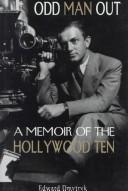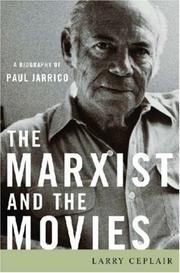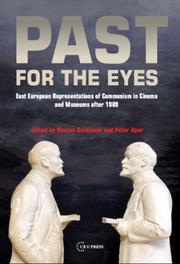| Listing 1 - 10 of 20 | << page >> |
Sort by
|
Book
ISBN: 1442237945 9781442237940 9781442237933 1442237937 Year: 2014 Publisher: Lanham Rowman & Littlefield Publishers
Abstract | Keywords | Export | Availability | Bookmark
 Loading...
Loading...Choose an application
- Reference Manager
- EndNote
- RefWorks (Direct export to RefWorks)
This volume compares films from the late Cold War era with films of the same genre, or of similar themes, from the post-Cold War era, paying particular attention to shifts in narrative that reflect changes in American culture, attitudes, and ideas. It explains how the absence of the Cold War has changed the way we understand and interpret film.
Motion pictures --- Cold War in motion pictures. --- Communism and motion pictures --- Communism and moving-pictures --- Motion pictures and communism --- Political aspects --- History

ISBN: 0585098298 9780585098296 0809319985 0809319993 Year: 1996 Publisher: Carbondale, IL Southern Illinois University Press
Abstract | Keywords | Export | Availability | Bookmark
 Loading...
Loading...Choose an application
- Reference Manager
- EndNote
- RefWorks (Direct export to RefWorks)
In 1947, the House Un-American Activities Committee rudely interrupted the successful career and life of Edward Dmytryk, citing him with contempt of Congress. As a result, Dmytryk was fired by RKO and spent three years in England before returning to the United States to serve a six-month jail sentence and undergo a second round of hearings, during which he recanted and provided evidence against several of his former colleagues. In this personal and perceptive book, Dmytryk vividly chronicles the history of a particularly turbulent era in American political life while examining his own life before and after the events universally called the witch hunts. He details his brief membership in the Communist Party of America, explaining his initial commitment to what he perceived as communist ideals of civil liberties, economic justice, and antifacism, followed by his eventual disillusionment with the party as it betrayed those ideals. He goes on to provide a fair assessment of what then happened to him and the effect it had on the rest of his life. Dmytryk describes the activities, prejudices, and personal behaviors of all the parties enmeshed in the congressional hearings on communism in Hollywood. His reactions to other members of the Hollywood Ten and his recollection of conversations with them lend his book an immediacy that is not only informative but also absorbing. Most importantly, he does not uphold an ideology but rather presents the events as he perceived them, understood them, and responded to them.
Motion picture producers and directors --- Communism and motion pictures --- Music, Dance, Drama & Film --- Film --- Communism and moving-pictures --- Motion pictures and communism --- Motion pictures --- Biography --- Dmytryk, Edward. --- Dmytryk, Edward, --- Dymtryk, Edward, --- Miller, Moe, --- Dmytryk, Edward --- Miller, Moe
Book
ISBN: 0253037875 0253037832 9780253037879 9780253037855 0253037859 9780253037831 0253037840 9780253037848 0253037840 Year: 2018 Publisher: Bloomington, Indiana
Abstract | Keywords | Export | Availability | Bookmark
 Loading...
Loading...Choose an application
- Reference Manager
- EndNote
- RefWorks (Direct export to RefWorks)
Motion pictures --- Communism and motion pictures --- Cinema --- Feature films --- Films --- Movies --- Moving-pictures --- Audio-visual materials --- Mass media --- Performing arts --- Communism and moving-pictures --- Motion pictures and communism --- Social aspects --- History and criticism

ISBN: 1283233282 9786613233288 0813173000 9780813173009 9780813137049 0813137047 9781283233286 6613233285 0813124530 9780813124537 Year: 2007 Publisher: Lexington University Press of Kentucky
Abstract | Keywords | Export | Availability | Bookmark
 Loading...
Loading...Choose an application
- Reference Manager
- EndNote
- RefWorks (Direct export to RefWorks)
As part of its effort to rid the nation of Communist influence and infiltration, the House Un-American Activities Committee subpoenaed hundreds of actors, screenwriters, producers, and directors with suspected ""Red"" leanings in 1947. Some of these film industry veterans, including screenwriter Paul Jarrico (1915--1997), refused to testify on Capitol Hill and were denied subsequent employment. In The Marxist and the Movies, Larry Ceplair illuminates the life, career, and political activism of Jarrico, the recipient of an Oscar nomination for his screenplay for Tom, Dick, and Harry (1941) a
Communism and motion pictures --- Blacklisting of entertainers --- Motion picture industry --- Screenwriters --- Communism and moving-pictures --- Motion pictures and communism --- Motion pictures --- Jarrico, Paul. --- Achilles, Peter, --- United States. --- HUAC --- Hollywood (Los Angeles, Calif.) --- History. --- HUAC (United States. Congress. House. Committee on Un-American Activities) --- House Un-American Activities Committee (U.S.)
Book
ISBN: 0801464684 0801464218 9780801464218 9780801450082 080145008X 132250539X 9780801464683 Year: 2012 Publisher: Ithaca, NY
Abstract | Keywords | Export | Availability | Bookmark
 Loading...
Loading...Choose an application
- Reference Manager
- EndNote
- RefWorks (Direct export to RefWorks)
Between 1942 and 1958, J. Edgar Hoover's Federal Bureau of Investigation conducted a sweeping and sustained investigation of the motion picture industry to expose Hollywood's alleged subversion of "the American Way" through its depiction of social problems, class differences, and alternative political ideologies. FBI informants (their names still redacted today) reported to Hoover's G-men on screenplays and screenings of such films as Frank Capra's It's a Wonderful Life (1946), noting that "this picture deliberately maligned the upper class attempting to show that people who had money were mean and despicable characters." The FBI's anxiety over this film was not unique; it extended to a wide range of popular and critical successes, including The Grapes of Wrath (1940), The Best Years of Our Lives (1946), Crossfire (1947) and On the Waterfront (1954).In J. Edgar Hoover Goes to the Movies, John Sbardellati provides a new consideration of Hollywood's history and the post-World War II Red Scare. In addition to governmental intrusion into the creative process, he details the efforts of left-wing filmmakers to use the medium to bring social problems to light and the campaigns of their colleagues on the political right, through such organizations as the Motion Picture Alliance for the Preservation of American Ideals, to prevent dissemination of "un-American" ideas and beliefs.Sbardellati argues that the attack on Hollywood drew its motivation from a sincerely held fear that film content endangered national security by fostering a culture that would be at best apathetic to the Cold War struggle at best, or, at its worst, conducive to communism at home. Those who took part in Hollywood's Cold War struggle, whether on the left or right, shared one common trait: a belief that the movies could serve as engines for social change. This strongly held assumption explains why the stakes were so high and, ultimately, why Hollywood became one of the most important ideological battlegrounds of the Cold War.
Cold War --- Communism and motion pictures --- Cold War in motion pictures. --- Motion pictures --- Communism and moving-pictures --- Motion pictures and communism --- Cinema --- Feature films --- Films --- Movies --- Moving-pictures --- Audio-visual materials --- Mass media --- Performing arts --- Social aspects --- Political aspects --- History. --- History and criticism --- United States. --- FBI --- FBR --- Federal Bureau of Investigation (U.S.) --- Federalʹnoe bi︠u︡ro rassledovaniĭ v SShA
Book
ISBN: 0748653600 1281357669 9786611357665 0748632433 9780748632435 Year: 2022 Publisher: Edinburgh
Abstract | Keywords | Export | Availability | Bookmark
 Loading...
Loading...Choose an application
- Reference Manager
- EndNote
- RefWorks (Direct export to RefWorks)
This book explores how Soviet film worked with time, the past, and memory. It looks at Stalinist cinema and its role in the production of history, the conversion of the present and experience into history, mechanisms of transfer, and what is located between history and the past. The representation of history is always the representation of power. The institution of legitimization and the mechanism for the production of identity, history is the past, constructed and served by the authorities who are attempting to curtail the experience by packaging it into a literary narrative and new visual im
Motion pictures --- Motion pictures and history. --- Motion pictures in propaganda --- Communism and motion pictures --- Communism and moving-pictures --- Motion pictures and communism --- Moving-pictures in propaganda --- Propaganda in motion pictures --- Propaganda --- History and motion pictures --- Moving-pictures and history --- History --- History.
Book
ISBN: 0813154774 0813146828 9780813146829 9780813146812 081314681X 9780813146805 0813146801 1322457565 9781322457567 9780813154770 Year: 2015 Publisher: Lexington The University Press of Kentucky
Abstract | Keywords | Export | Availability | Bookmark
 Loading...
Loading...Choose an application
- Reference Manager
- EndNote
- RefWorks (Direct export to RefWorks)
James Dalton Trumbo (1905--1976) is widely recognized for his work as a screenwriter, playwright, and author, but he is also remembered as one of the Hollywood Ten who opposed the House Un-American Activities Committee. Refusing to answer questions about his prior involvement with the Communist Party, Trumbo sacrificed a successful career in Hollywood to stand up for his rights and defend political freedom.In Dalton Trumbo, authors Larry Ceplair and Christopher Trumbo present thier extensive research on the famed writer, detailing his work, his membership in the Communist Party, his long camp
Screenwriters --- Authors, American --- Blacklisting of authors --- Communism and motion pictures --- English --- Languages & Literatures --- American Literature --- Communism and moving-pictures --- Motion pictures and communism --- Motion pictures --- American authors --- Screen writers --- Authors --- Motion picture authorship --- Trumbo, Dalton, --- Rich, Robert, --- טרמבו, דאלטון, --- Political and social views.
Book
ISBN: 0253050650 Year: 1975 Publisher: Indiana University Press
Abstract | Keywords | Export | Availability | Bookmark
 Loading...
Loading...Choose an application
- Reference Manager
- EndNote
- RefWorks (Direct export to RefWorks)
Film and Revolution is an arresting new contribution to film studies by a critic who has constructed an aesthetic of the cinema grounded in Marxian ideology. The longest part of the book, devoted to Jean-Luc Godard, shows how Godard hopes to make his contribution to the revolution of society by inventing a revolutionary cinema. Essays present intelligent, probing analyses of Godard's later major films: Two or Three Things I Know about Her, La Chinoise, Made in USA, Weekend, Le Cai Savoir, One Plus One, Wind from the East, British Sounds, and Tout va bien. Part II,"Film and Revolution on Many Fronts," turns to film making in the Third World and elsewhere, analyzing films by Solanas, Kramer, Rossellini, Makavejev, Ophuls, Harris, and Petri. In Part Ill MacBean examines the semiology of the cinema proposed by Christian Metz and attacks his failure to come to terms with ideology. Finally, MacBean attempts to demystify the ideological package offered by the mass media, particularly the class struggle that is eclipsed by TV and the cinema. Illustrated with more than forty black-and-white stills.
Revolution. --- Film. --- Motion pictures --- Communism and motion pictures. --- Cinema --- Political aspects. --- Aspect politique. --- Feature films --- Films --- Movies --- Moving-pictures --- Audio-visual materials --- Mass media --- Performing arts --- Communism and moving-pictures --- Motion pictures and communism --- History and criticism --- Film history, theory & criticism
Book
ISBN: 9781848850088 1848850085 1848850093 9781848850095 Year: 2010 Volume: *5 Publisher: London Tauris
Abstract | Keywords | Export | Availability | Bookmark
 Loading...
Loading...Choose an application
- Reference Manager
- EndNote
- RefWorks (Direct export to RefWorks)
"When the Bolsheviks seized power in the Soviet Union during 1917, they were suffering from a substantial political legitimacy deficit. Uneasy political foundations meant that they were always on the defensive and cinema became a key part of the strategy to protect the existence of the USSR. This welcome book shows how one of film's central functions was as an important means of convincing the masses that the regime was legitimate and a bearer of historical truth. Based on extensive research in archives and primary sources, the book examines the interaction between politics and the Soviet cinema industry during the period between Stalin's rise to power and the beginning of the Great Patriotic War. This was the era when the Bolsheviks were trying to develop a 'cinema for the millions', which sought to engage Soviet citizens politically by carefully blending entertainment with the communist message. Jamie Miller investigates how political and administrative decision-making, censorship, thematic planning and purges were shaped by the Bolsheviks' defensive outlook, which in turn had a largely negative impact on the production process. He examines the role of film unions and societies, compares the development of two different studios and looks at the education system for cinema personnel. He also analyses key films of the period, including the classic musical Circus, the class enemy drama The Party Card and the political epic The Great Citizen."--Page 4 of cover.
Motion pictures --- Motion pictures in propaganda --- Communism and motion pictures --- Political aspects --- History --- #SBIB:309H1313 --- Communism and moving-pictures --- Motion pictures and communism --- Moving-pictures in propaganda --- Propaganda in motion pictures --- historia --- Cinéma dans la propagande --- Communisme et cinéma --- Cinéma dans la propagande --- Communisme et cinéma --- Film --- Russia --- Cinéma --- Aspect politique --- Propaganda --- History. --- Geschiedenis en/of organisatie van het filmwezen: algemeen en per land (met inbegrip van de rol van het filmwezen in de ontwikkelingsproblematiek)

ISBN: 9786155211430 9789639776050 9789639776036 963977605X 9639776033 2821815220 9786611128944 1281128945 1435612361 6155211434 9781435612365 6611128948 Year: 2008 Publisher: Budapest New York Central European University Press
Abstract | Keywords | Export | Availability | Bookmark
 Loading...
Loading...Choose an application
- Reference Manager
- EndNote
- RefWorks (Direct export to RefWorks)
How do museums and cinema shape the image of the Communist past in today’s Central and Eastern Europe? This volume is the first systematic analysis of how visual techniques are used to understand and put into context the former regimes. After history “ended” in the Eastern Bloc in 1989, museums and other memorials mushroomed all over the region. These efforts tried both to explain the meaning of this lost history, as well as to shape public opinion on their society’s shared post-war heritage. Museums and films made political use of recollections of the recent past, and employed selected museum, memorial, and media tools and tactics to make its political intent historically credible. Thirteen essays from scholars around the region take a fresh look at the subject as they address the strategies of fashioning popular perceptions of the recent past.
Communism and motion pictures. --- Communisme et cinéma --- Communisme et cinéma --- Communism and moving-pictures --- Motion pictures and communism --- Communism --- Motion pictures --- Museums. --- Bolshevism --- Communist movements --- Leninism --- Maoism --- Marxism --- Trotskyism --- Collectivism --- Totalitarianism --- Post-communism --- Socialism --- Village communities --- Cinema --- Feature films --- Films --- Movies --- Moving-pictures --- Audio-visual materials --- Mass media --- Performing arts --- History and criticism --- Cinéma --- Communisme --- Musées --- Communism and motion pictures --- Museums --- E-books --- Cultural studies, Fascism, Film, Media, Memory in art, Memory politics, Museums, Postcommunism.
| Listing 1 - 10 of 20 | << page >> |
Sort by
|

 Search
Search Feedback
Feedback About UniCat
About UniCat  Help
Help News
News